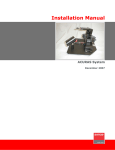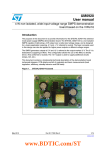Download User`s manual - NN Acoustics
Transcript
USER`S MANUAL POSITIONING OF DEFLECTOR PADS N.N.Acoustics does not recommend listening without deflector pads. In your kit you will find 4 pieces of deflector pads made of special sponge material. Their function is to vertically disperse sound waves emitted by the ribbon. The enclosed marker will help you to properly position the pads. Follow these simple steps: 1. Position the marker carefully 2. Put one deflector pad, … The pads are magnetic, so they will stand by themselves. … then the other. 3. Remove the marker carefully. Ideally, deflector pads should be 11 teeth apart. POWER REQUIREMENTS How much power must your amplifier have? To answer this question, you have to consider the following factors: 1. How loud do you like your music? Warning – being exposed to loudness of 100db or more for a long period of time may damage your hearing. The louder you like your music, the more power from your amplifier is needed, notwithstanding the efficiency of your speakers and the size of the room. To achieve the most realistic sound possible, the loudness has to be at a suitable level. You should know that the average level of speech is around 64 db when you are 1 m away from the speaker. Yelling has a level of around 84 db at 1m distance from the speaker. 2. What is the efficiency of your loudspeakers? The average sensitivity of a loudspeaker is 87 db/1w/1m. If your loudspeakers have the sensitivity of 90 db/1w/1m, that means that they need twice as less power from the amplifier to reach the same loudness level as the speakers that have 87 db/1w/1m. If your loudspeakers have the sensitivity of 84 db/1w/1m, that means that they need twice as much power from the amplifier to reach the same loudness level as the speakers that have 87 db/1w/1m. 3. What is the size and what are the properties of the room in which you listen to music? The smaller the room, the less power from the amplifier you need and vice versa. In a room with mostly bare walls and with little furniture the sound will be louder and you will have the illusion that the room is bigger than it really is. In a room with paintings and shelves on walls and with lots of furniture the sound will be softer and you will have the illusion that the room is smaller than it really is. The bigger the distance between you and the loudspeakers, the loudness level has to be higher. If you are listening to music in company, you will need the music louder than if you are alone. It is advisable that your sound system always operates in optimal conditions. Even if a loudness level much higher than your average is required from your loudspeakers, your system has to meet this requirement with no effort. This means that at no time the sound should be audibly distorted, undefined, aggressive or sharp. Even at maximum working regimes the amplifier must have enough spare power and must not compress the sound dynamics. If you came up with the fact that for average listening conditions you need for example 50w per channel, add to that at least 3 db, still better 6 db, for the spare power. This totals 100w, or better 200w, per channel. Every 3db added means doubling the power of the amplifier. All things considered, the power that you need from your amplifier may vary from 20w to 200w. POSITIONING OF LOUDSPEAKERS To make the most of your loudspeakers you have to experiment. But don’t worry - your effort will be awarded by taking great pleasure in enjoying your favourite music. When positioning your loudspeakers, you should avoid spots with direct sunlight. Compared to competition, N.N. ACOUSTICS loudspeakers are far less demanding when it comes to positioning them in your room. Nevertheless, it is advisable to follow a certain procedure. It is important that all adjustments should be slight. After every adjustment listen carefully to tunes you know well. Don’t limit yourself to material that has only several instruments playing, but rather listen to big performance bodies like orchestras, choirs, big bends and live recordings. When positioning loudspeakers in your space, try to avoid corners of the room as much as you can. Avoid front and side walls as well. Of course you have to bear in mind that for the basic stereo sound picture the minimal distance between vertical axes of the speakers is 1.8 m. The distance from the loudspeakers to the front wall has to be longer than the distance from the loudspeakers to the side walls. Also, the distance from the side wall to the centre of the bass or mid-bass speaker has to be longer than the distance from the floor to the centre of the bass or mid-bass speaker. If possible, the distances between the side walls and each loudspeaker should be the same. The initial toe-ins of the loudspeaker towards the listening position should be slight (2-3 degrees). In the space between the speakers you should achieve a complete sound picture, with clearly defined focus. The best way to test this is listening to a female vocal that has to be in the centre. If you hear that the sound is coming from both speakers and the centre is empty, you should toe in the loudspeakers towards the listening position until the space between the loudspeakers is completely filled with sound. In this and other cases, you should of course go by the rule of slight adjustments. The sound picture should spread out of both loudspeakers into the surrounding area, but not more than 30-40 cm. For models PHOENIX and RUBYCON the toe-in is between 2 and 10 degrees. For model MASTERPIECE the toe-in is between 1 and 7 degrees. For model K2 (to be determined). For model XENIA the toe-in is between 3 and 6 degrees. The distance from the loudspeakers to the listening position should not be shorter than the distance between the vertical axes of the speakers. It is advisable that the loudspeakers should lean backwards very slightly. The reason is not the direction of the ribbons, but rather the size of the sound picture. With optimal adjustment, the sound picture spreads into the whole space between and around the loudspeakers, having adequate depth and height. The focus is defined, with precise location of all instruments and vocals. When listening to some choirs, every single vocal will be precisely defined. You should have no trouble distinguishing the picture of the tone colour of the space where the recording has been made, the size of the place and the smallest details from the recording as well. In short, you will have the feeling that you are at the actual site of the performance, be it recording studio, concert hall, club or arena. BREAK-IN N.N.Acoustics loudspeakers require a certain break-in period before reaching maximum quality sound. Every pair of loudspeakers is subjected to intensive listening tests before they are ready for packaging. For other loudspeaker manufacturers this is not feasible. The break-in period has been significantly reduced for you. It only leaves you with some 50 hours of listening at moderate levels before you reach the full potential of the loudspeakers. LOUDSPEAKER CARE N.N.Acoustics loudspeakers are made with natural veneer or solid wood and treated with high quality oils and waxes, so they require adequate care. Warning Since neodymium magnet has a very strong magnetic field, do not put any metal objects within 10 cm of the ribbon speaker. You could damage the protection grid, or even worse – rip the ribbon which is only 4 microns thick. General Rules When positioning your loudspeakers, you should avoid spots with direct sunlight. Also avoid direct source of heat (it should be at least 60 cm away). With fan heaters, especially avoid heat being directed towards the speakers. Avoid placing decorations or any other objects on top of the speakers. Cleaning Warning – do not use vacuum cleaner. Remove dust with a clean, dry, soft cotton cloth, preferably the one that comes with the loudspeakers. Avoid magic cloths and sponges. Do not use any fluid cleaners that contain solvents, silicone or abrasives. Do not use any cleaners for granite surfaces or for speaker units. Do not touch the visible parts of bass, mid-bass or ribbon speakers with your fingers. Do the dusting with a soft brush. Do not blow into the ribbon speakers. It is advisable to treat the speaker cabinets every 3 to 4 years with the wax that comes with them. This way they will keep the brand new look for a long period of time. LIMITED WARRANTY N.N. Acoustics gives a 5 year warranty for the materials, manufacturing and proper functioning of this product. If there should be any defects in the materials, manufacturing or functioning of this N.N. Acoustics product within the warranty period starting from the date of purchase, the product shall be repaired or replaced by N.N. Acoustics or an authorized dealer with no additional charge within 60 days of the day product was returned to N.N. Acoustics. The warranty shall be granted only with enclosed original receipt or other proof of purchase. The warranty is transferable within the original 5 year period. The warranty does not cover the damage which is done intentionally, caused by accident, irregular handling or irregular usage. This warranty is in effect as of the day of purchase and no additional registration is required.












